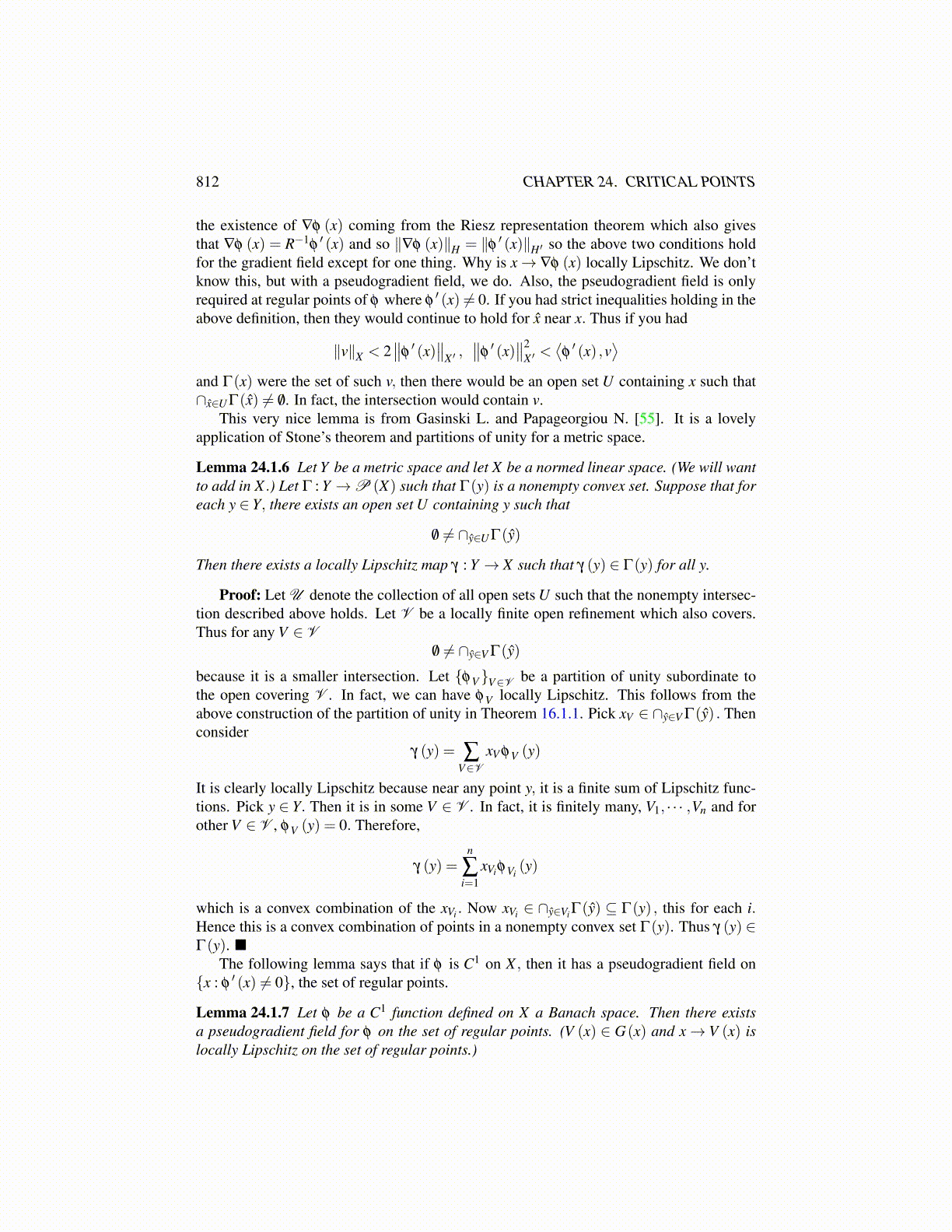
812 CHAPTER 24. CRITICAL POINTS
the existence of ∇φ (x) coming from the Riesz representation theorem which also givesthat ∇φ (x) = R−1φ
′ (x) and so ∥∇φ (x)∥H = ∥φ ′ (x)∥H ′ so the above two conditions holdfor the gradient field except for one thing. Why is x→ ∇φ (x) locally Lipschitz. We don’tknow this, but with a pseudogradient field, we do. Also, the pseudogradient field is onlyrequired at regular points of φ where φ
′ (x) ̸= 0. If you had strict inequalities holding in theabove definition, then they would continue to hold for x̂ near x. Thus if you had
∥v∥X < 2∥∥φ′ (x)
∥∥X ′ ,
∥∥φ′ (x)
∥∥2X ′ <
⟨φ′ (x) ,v
⟩and Γ(x) were the set of such v, then there would be an open set U containing x such that∩x̂∈U Γ(x̂) ̸= /0. In fact, the intersection would contain v.
This very nice lemma is from Gasinski L. and Papageorgiou N. [55]. It is a lovelyapplication of Stone’s theorem and partitions of unity for a metric space.
Lemma 24.1.6 Let Y be a metric space and let X be a normed linear space. (We will wantto add in X .) Let Γ : Y →P (X) such that Γ(y) is a nonempty convex set. Suppose that foreach y ∈ Y, there exists an open set U containing y such that
/0 ̸= ∩ŷ∈U Γ(ŷ)
Then there exists a locally Lipschitz map γ : Y → X such that γ (y) ∈ Γ(y) for all y.
Proof: Let U denote the collection of all open sets U such that the nonempty intersec-tion described above holds. Let V be a locally finite open refinement which also covers.Thus for any V ∈ V
/0 ̸= ∩ŷ∈V Γ(ŷ)
because it is a smaller intersection. Let {φV}V∈V be a partition of unity subordinate tothe open covering V . In fact, we can have φV locally Lipschitz. This follows from theabove construction of the partition of unity in Theorem 16.1.1. Pick xV ∈ ∩ŷ∈V Γ(ŷ) . Thenconsider
γ (y) = ∑V∈V
xV φV (y)
It is clearly locally Lipschitz because near any point y, it is a finite sum of Lipschitz func-tions. Pick y ∈ Y. Then it is in some V ∈ V . In fact, it is finitely many, V1, · · · ,Vn and forother V ∈ V , φV (y) = 0. Therefore,
γ (y) =n
∑i=1
xViφVi(y)
which is a convex combination of the xVi . Now xVi ∈ ∩ŷ∈ViΓ(ŷ) ⊆ Γ(y) , this for each i.Hence this is a convex combination of points in a nonempty convex set Γ(y). Thus γ (y) ∈Γ(y).
The following lemma says that if φ is C1 on X , then it has a pseudogradient field on{x : φ
′ (x) ̸= 0}, the set of regular points.
Lemma 24.1.7 Let φ be a C1 function defined on X a Banach space. Then there existsa pseudogradient field for φ on the set of regular points. (V (x) ∈ G(x) and x→ V (x) islocally Lipschitz on the set of regular points.)